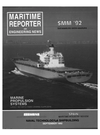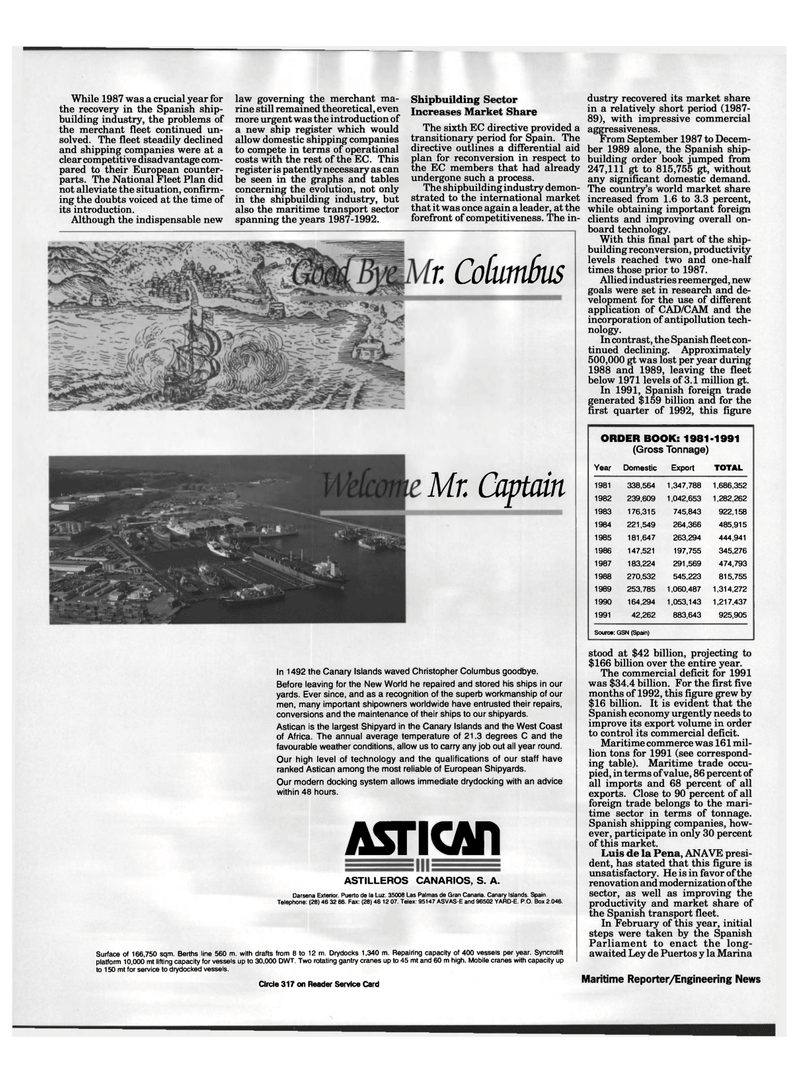
Page 22: of Maritime Reporter Magazine (September 1992)
Read this page in Pdf, Flash or Html5 edition of September 1992 Maritime Reporter Magazine
While 1987 was a crucial year for the recovery in the Spanish ship- building industry, the problems of the merchant fleet continued un- solved. The fleet steadily declined and shipping companies were at a clear competitive disadvantage com- pared to their European counter- parts. The National Fleet Plan did not alleviate the situation, confirm- ing the doubts voiced at the time of its introduction.
Although the indispensable new law governing the merchant ma- rine still remained theoretical, even more urgent was the introduction of a new ship register which would allow domestic shipping companies to compete in terms of operational costs with the rest of the EC. This register is patently necessary as can be seen in the graphs and tables concerning the evolution, not only in the shipbuilding industry, but also the maritime transport sector spanning the years 1987-1992.
Shipbuilding Sector
Increases Market Share
The sixth EC directive provided a transitionary period for Spain. The directive outlines a differential aid plan for reconversion in respect to the EC members that had already undergone such a process.
The shipbuilding industry demon- strated to the international market that it was once again a leader, at the forefront of competitiveness. The in- r. Columbus
Mr. Captain
In 1492 the Canary Islands waved Christopher Columbus goodbye.
Before leaving for the New World he repaired and stored his ships in our yards. Ever since, and as a recognition of the superb workmanship of our men, many important shipowners worldwide have entrusted their repairs, conversions and the maintenance of their ships to our shipyards.
Astican is the largest Shipyard in the Canary Islands and the West Coast of Africa. The annual average temperature of 21.3 degrees C and the favourable weather conditions, allow us to carry any job out all year round.
Our high level of technology and the qualifications of our staff have ranked Astican among the most reliable of European Shipyards.
Our modern docking system allows immediate drydocking with an advice within 48 hours.
AsncAn
ASTILLEROS CANARIOS, S. A.
Darsena Exterior. Puerto de la Luz. 35008 Las Palmas de Gran Canaria. Canary Islands. Spain
Telephone: (28) 46 32 66. Fax: (28) 46 12 07. Telex: 95147 ASVAS-E and 96502 YARD-E. P.O. Box 2.046.
Surface of 166,750 sqm. Berths line 560 m. with drafts from 8 to 12 m. Drydocks 1,340 m. Repairing capacity of 400 vessels per year. Syncrolift platform 10,000 mt lifting capacity for vessels up to 30,000 DWT. Two rotating gantry cranes up to 45 mt and 60 m high. Mobile cranes with capacity up to 150 mt for service to drydocked vessels.
Circle 317 on Reader Service Card dustry recovered its market share in a relatively short period (1987- 89), with impressive commercial aggressiveness.
From September 1987 to Decem- ber 1989 alone, the Spanish ship- building order book jumped from 247,111 gt to 815,755 gt, without any significant domestic demand.
The country's world market share increased from 1.6 to 3.3 percent, while obtaining important foreign clients and improving overall on- board technology.
With this final part of the ship- building reconversion, productivity levels reached two and one-half times those prior to 1987.
Allied industries reemerged, new goals were set in research and de- velopment for the use of different application of CAD/CAM and the incorporation of antipollution tech- nology.
In contrast, the Spanish fleet con- tinued declining. Approximately 500,000 gt was lost per year during 1988 and 1989, leaving the fleet below 1971 levels of 3.1 million gt.
In 1991, Spanish foreign trade generated $159 billion and for the first quarter of 1992, this figure
ORDER BOOK: 1981 -1991 (Gross Tonnage)
Year Domestic Export TOTAL 1981 338,564 1,347,788 1,686,352 1982 239,609 1,042,653 1,282,262 1983 176,315 745,843 922,158 1984 221,549 264,366 485,915 1985 181,647 263,294 444,941 1986 147,521 197,755 345,276 1987 183,224 291,569 474,793 1988 270,532 545,223 815,755 1989 253,785 1,060,487 1,314,272 1990 164,294 1,053,143 1,217,437 1991 42,262 883,643 925,905
Source: GSN (Spain) stood at $42 billion, projecting to $166 billion over the entire year.
The commercial deficit for 1991 was $34.4 billion. For the first five months of 1992, this figure grew by $16 billion. It is evident that the
Spanish economy urgently needs to improve its export volume in order to control its commercial deficit.
Maritime commerce was 161 mil- lion tons for 1991 (see correspond- ing table). Maritime trade occu- pied, in terms of value, 86 percent of all imports and 68 percent of all exports. Close to 90 percent of all foreign trade belongs to the mari- time sector in terms of tonnage.
Spanish shipping companies, how- ever, participate in only 30 percent of this market.
Luis de la Pena, ANAVE presi- dent, has stated that this figure is unsatisfactory. He is in favor of the renovation and modernization ofthe sector, as well as improving the productivity and market share of the Spanish transport fleet.
In February of this year, initial steps were taken by the Spanish
Parliament to enact the long- awaited Ley de Puertos y la Marina
Maritime Reporter/Engineering News

 21
21

 23
23
